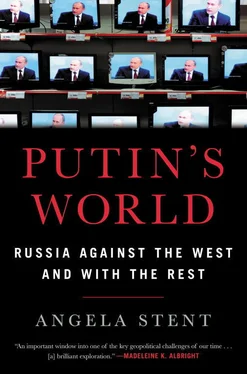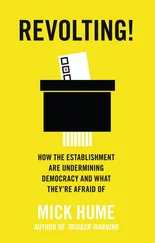Yet while Russia and Saudi Arabia were able to cooperate on oil prices, the Saudis became increasingly incensed after Russia moved in militarily to bolster Assad. Iran’s support of Assad—together with that of Russia—threatened to weaken Saudi influence in the Middle East. The Saudis backed Syrian opposition groups but were angered by the United States’ reluctance to give more robust support to these groups. However, as it became increasingly clear that Russia would make sure that Assad stayed in power and prevailed over his opponents, the Saudis, like the Turks, apparently calculated that it was better to establish closer links with Russia than continue to support a losing cause. As the then thirty-one-year-old MBS said, “The main objective is not to have Russia place all its cards in the region behind Iran.” 66Thus Russia has been the beneficiary of regional rivalries in the Middle East that long predate its reentry into the area after 2000.
After Donald Trump’s election, the Saudis went out of their way to woo the new US president. They succeeded, and his first foreign trip after his election was to the kingdom. During his stay he was lavished with extravagant royal pomp, including participation in an elaborate sword dance. The Saudis signed a memorandum of understanding for a large arms deal, and the US-Saudi relationship seemed to be reinvigorated. A few months later, the aging king made his historic visit to Russia. His son and heir to the throne had launched his ambitious Saudi Vision 2030 program for modernizing the kingdom, designed to turn it from an oil exporter into a regional powerhouse with a diversified economy. Forging a partnership with Russia was part of this grand design. This was also an opportunity for the Kremlin to build a relationship with a traditional US ally. The possibility to use the leverage it derived from its close ties to Saudi Arabia’s archrival, Iran, was very welcome, as its relations with the West continued to deteriorate. Russia is now an important interlocutor for two countries that officially are antagonists but who are united in their antipathy toward Iran and their desire to have Moscow use its influence to pressure Tehran—namely Saudi Arabia and Israel.
During King Salman’s October 2017 visit to Moscow, the Saudis signed an agreement to purchase Russian S-400 air-defense missiles (Iran has only the older S-300 version) and to transfer Russian technology to the kingdom for the production of several advanced Russian weapons systems. The Saudis in return agreed to invest $1 billion in Russian energy projects, and Russia will build a $1.1 billion petrochemical plant in the kingdom. 67While the Saudis may have few illusions that they can split Tehran from Moscow, they understand that Russia now plays the role of great power balancer in the region. They, like the Turks, have come around to accepting that they must work with Russia on Syria. As one regional expert said, “The Saudis now realize that the Russians could be the only party that can settle the Syria conflict…. They don’t have a problem with the idea that the regime can stay.” 68
Putin has succeeded in cementing ties with Saudi Arabia in a relationship focused on energy and Iran. Indeed, Iran remains a key partner in Putin’s world.
IRAN
The Iran-Russia relationship has historically been quite fraught. After all, in the eighteenth and nineteenth centuries, the Russian and Persian empires fought four wars, as a result of which Persia lost the three South Caucasus states and Dagestan to Russia. The USSR also supported secessionist movements in Iran in the 1920s and occupied Northern Iran after World War Two. During the Soviet Afghan War, more than two million Afghan refugees fled to Iran, putting great strain on its budget. And Moscow’s support for Saddam during the Iran-Iraq War further alienated the new Islamic republic. Relations improved after the fall of the Soviet Union. But they entered a more intense phase after Putin became president and determined to reprioritize Moscow’s ties to Tehran. The countries have grown closer since Russia entered the war in Syria and since Donald Trump’s election.
In the early part of Putin’s tenure in office, Iran’s nuclear program not only was the focus of Russian-Iranian relations but was also a major issue in US-Russia relations. Russia remained committed to building the Bushehr reactor, asserting that Iran was not seeking to acquire a nuclear weapons capability, while the US and the EU were far more concerned about longer-term Iranian nuclear ambitions. Russia appeared to accept the prospect of a nuclear Iran with relative equanimity. As one of Russia’s top Middle East experts put it, “A few years back, I heard one of our diplomats say: ‘A pro-American Iran is far more dangerous for us than a nuclear Iran.’” 69During the Bush administration, Russia was reluctant to yield to US pressure not to build Bushehr. The construction of the reactor brought needed revenues and the promise that, once it was completed, orders for more nuclear power plants would be forthcoming. Putin has prioritized Russia’s nuclear power industry. Bushehr was to be the flagship project that would advance Russia’s global role as a leading exporter of nuclear power plants.
However, in 2004 the International Atomic Energy Agency (IAEA) found that Iran was hiding information about its nuclear activities and reneging on agreements it had already made. Russia began to delay the completion of the reactor, much to Iran’s annoyance; it was finally completed in 2011. Russia also vacillated between cooperating with the United Nations Security Council to censure Iran and arguing that Iran was not violating its IAEA obligations. Moscow too came under pressure from the West not to supply Tehran with the S-300 surface-to-air missiles it had agreed to sell in 2007, a deal that would have netted Russia $800 million. When Medvedev became president, he froze the deal.
Indeed, Medvedev supported much tougher UN sanctions against Tehran after President Obama showed him evidence of Iran’s secret uranium enrichment facility near Qom. These punitive sanctions helped bring Iran to the negotiating table with the five permanent members of the UN Security Council, plus Germany and the EU. These negotiations resulted in the 2015 Joint Comprehensive Plan of Action (JCPOA), which commits Iran to greatly reducing the number of centrifuges it has and to not engaging in significant uranium enrichment for ten years. President Obama praised Russia for its help in ensuring the deal was completed. Candidate Trump insisted that the United States would pull out of the deal were he to win the White House, and in May 2018, he followed through on that promise, to the dismay of Russia, China, and the European co-signatories. Russia accused the United States of “trampling upon the standards of international law” and committed itself to working with the other JCPOA signatories to saving the deal. 70
Since the signing of the JCPOA, Russia has significantly increased its military cooperation with Iran. Russia and Iran have signed wide-ranging agreements in military education, anti-terrorism, and modernization of Iran’s air force. Iran is also interested in buying a broad range of Russian military hardware, but so far progress on signing deals has been modest. In 2014, Russia signed agreements to build another eight nuclear reactors in Iran, although the timetable for these deals is, at best, unclear. Beyond these arms and nuclear energy deals, Iranian-Russian economic relations are quite modest. 71After the UN sanctions against Iran were lifted, Iran and Russia signed deals worth $40 billion, compared to Iran and China signing a twenty-five-year road map that envisages bilateral trade rising to $600 billion. 72And it is the United States, France, and the UK—not Russia—that have educated many Iranian politicians and intellectuals, including its current president, foreign minister, and former chief weapons negotiator.
Читать дальше












